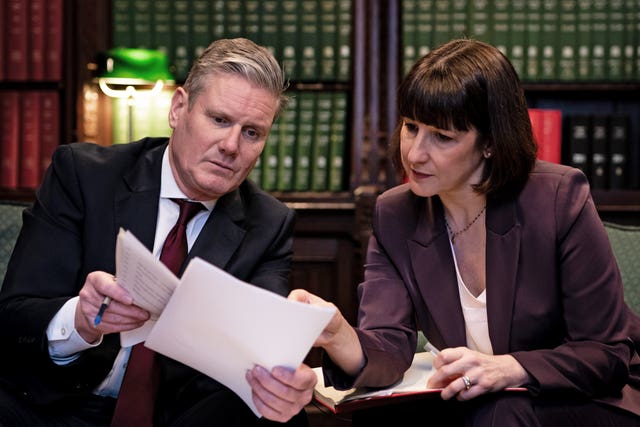
Labour’s Rachel Reeves has said a plan to crack down on tax dodgers to fill a hole in her spending plans is not “rocket science”.
The shadow chancellor was forced to respond after Jeremy Hunt used his Budget to adopt some of Labour’s revenue-raising policies to fund his pre-election cut in national insurance.
Ms Reeves has set out how she will raise £5 billion a year by the end of the next parliament by narrowing the “tax gap” – the difference between the amount of money HM Revenue & Customs (HMRC) is owed and the amount it actually receives.

Labour also hopes to raise £2.6 billion over the next parliament by closing “loopholes” in the Government’s plans to abolish exemptions for “non-doms”, people who are not “domiciled” in the UK for tax purposes.
The Chancellor announced changes to the non-dom status, which Labour had earmarked to fund commitments on schools and the NHS, in his March Budget alongside an extension of the windfall tax on oil and gas firms, throwing Ms Reeves’ plans into disarray.
She has now decided that Labour will work on closing the tax gap, which had widened to £36 billion in 2021/22, £5 billion more than it had been the previous year, as an under-resourced HMRC struggled to collect revenues and manage compliance.
The party said it would invest up to £555 million a year in boosting the number of compliance officers at HMRC.
It will also consider requiring more tax schemes to be registered with HMRC to make sure they are legitimate, and plans a focus on offshore tax compliance.
Ms Reeves told BBC Breakfast she could “ramp up” the number of HMRC staff “pretty quickly” if Labour won the election.
“At the start you might need to bring in extra resource but then you need to train people up within the government to do this work.
“This isn’t rocket science – previous governments have managed to close that tax gap, as it’s called.”
She added: “The Government’s plans that they announced in March about non-doms, they said they were taking our policy; well, it turns out they’ve taken it but left a load of loopholes in it.
“And so if you are a non-dom you can still get out of paying inheritance tax: in the first year of their policy there’s a 50% discount, we don’t get 50% discounts on our taxes.
“People who go out and work today – teachers, plumbers, doctors – they don’t get a 50% discount. Why should some of the wealthiest people in the country get that discount? We would abolish that and we would put that money into frontline public services, where it belongs.”
On Monday, Labour also announced a new expert panel including former Treasury permanent secretary Sir Edward Troup and veteran MP Dame Margaret Hodge to advise on ways to close the tax gap.
Chaired by shadow Treasury minister James Murray, the panel is expected to feed into Labour’s manifesto and its plans for government should it win the next election.
Ms Reeves told ITV she hoped the panel would “give people confidence that we will be able to bring in the money that’s needed to fund those much-needed public services”.
While the measures are expected to raise more than £5 billion a year by the end of the Parliament, only £2 billion of that money will go to funding NHS appointments and primary school breakfast clubs, with the rest being kept back for other priorities.
Ms Reeves told BBC Radio 4’s Today programme: “This is the worst economic inheritance since the Second World War and it will constrain what an incoming government could do, but there’s always choices to be made.”
“And the choices that I’m announcing today are that we will strengthen the rules to ensure that non-doms pay their fair share of tax and we will crack down on tax avoidance and ensure the tax code is fully complied with to bring in over £5 billion a year by the end of the parliament.”
But Labour’s focus on clamping down on tax avoidance comes amid continued pressure on deputy leader Angela Rayner over her own financial affairs.
She has faced repeated questions from the Tories over whether she should have paid capital gains tax on the 2015 sale of her home due to confusion over whether it was her principal residence.
Ms Rayner said she had received professional advice which was “categoric that I do not owe any capital gains tax on that”.
Asked about the situation, Ms Reeves said: “Angela has answered questions about this in quite some detail, and she’s also sought additional tax and legal advice.
“And she is confident, and I am confident, that she has paid the tax that was owed. All this is from a decade ago, the living arrangements with her and her ex-husband before she was a Member of Parliament.”
Treasury minister Nigel Huddleston said: “Labour hasn’t changed. When it comes to tax – it’s one rule for the British people, another rule for the Labour leadership.
“The shadow chancellor is committed to the same old Labour policies – back to square one with higher spending, higher borrowing and higher taxes.”

Enjoy the convenience of having The Sunday Post delivered as a digital ePaper straight to your smartphone, tablet or computer.
Subscribe for only £5.49 a month and enjoy all the benefits of the printed paper as a digital replica.
Subscribe